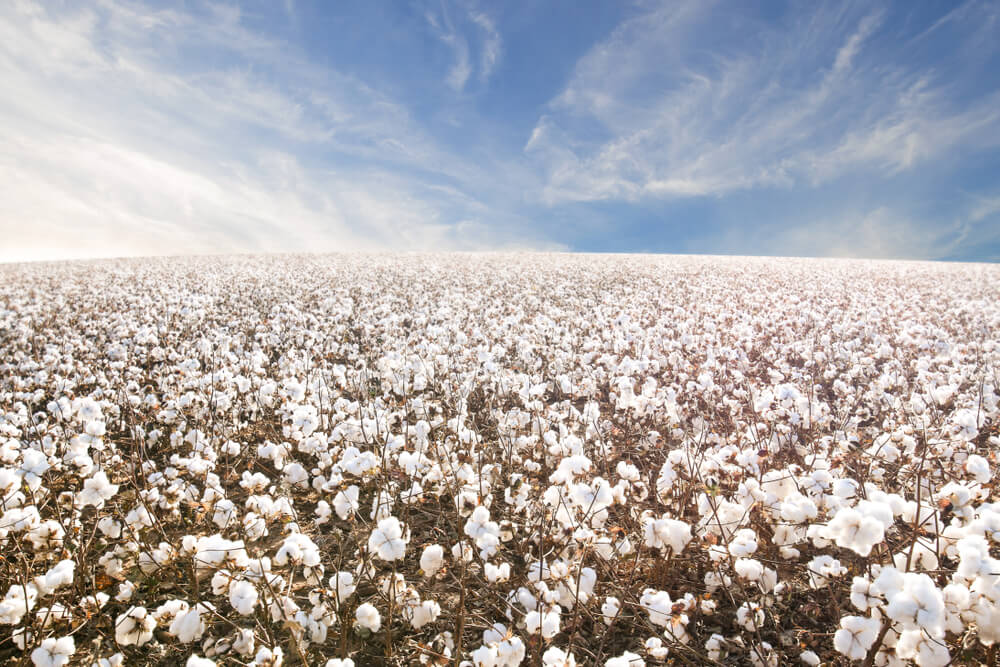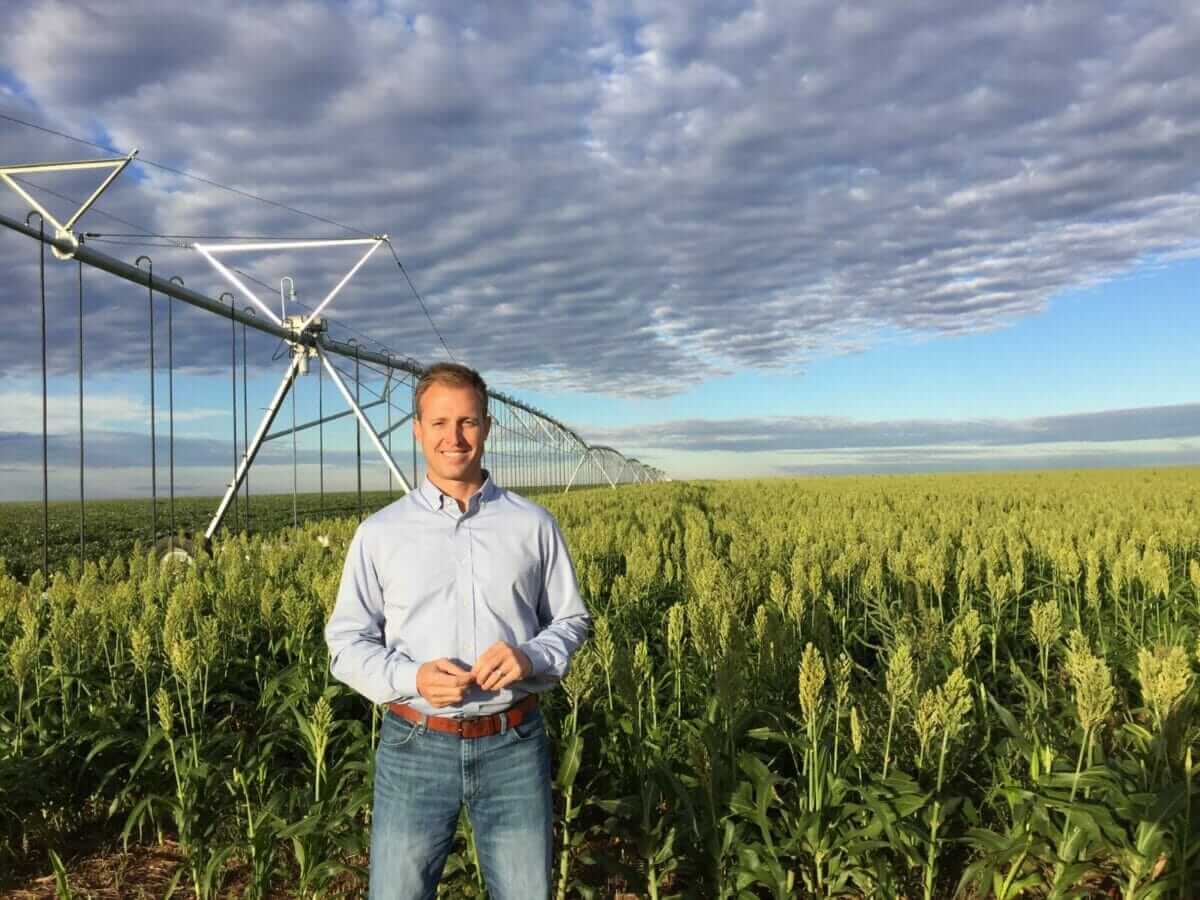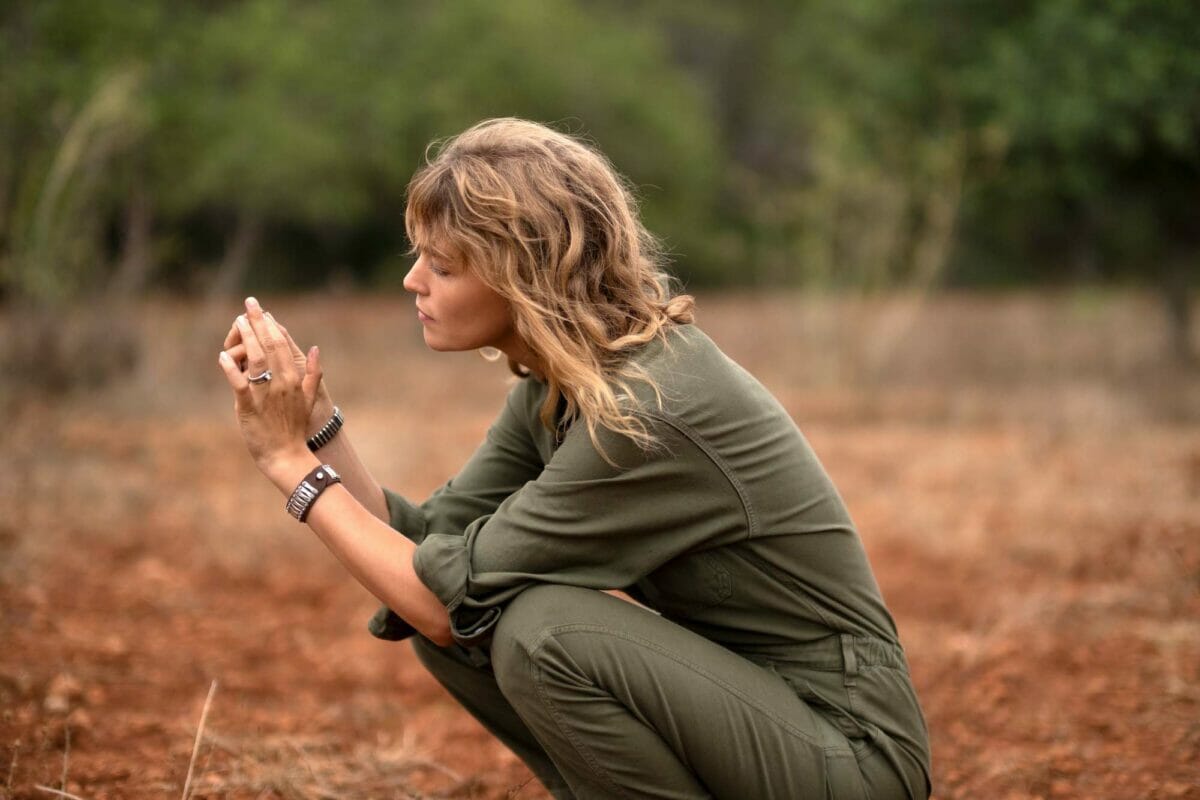It’s Time For Fashion to Talk More About Regenerative Agriculture
For fiber and textile producers, the path to growing sustainable cotton, hemp and flax is complicated.
It’s Time For Fashion to Talk More About Regenerative Agriculture
For fiber and textile producers, the path to growing sustainable cotton, hemp and flax is complicated.

Cotton fields in Texas.by Megan Betteridge, Shutterstock.
For many food crops, the process of getting from the field to your fork is relatively simple. Take an apple, for instance. It’s picked and cleaned, then graded to see where it will end up. If it’s bound for the supermarket, it’s tagged and put on a pallet with other apples before it’s loaded onto a supply truck. That process gets a bit more complicated for imported or exported foods, but it’s a similar procedure.
Now take a cotton dress. Before it ended up on a store hanger, it was grown in a field. But how did it get to the store? First, the cotton was picked and cleaned by the farmer, just like our apple. It was also graded to determine if it could be woven into fiber. The cotton was bundled together and shipped from the farm where it was grown to the processor, perhaps located in Vietnam or India. Those processors weave the cotton into a yarn or workable fiber and then send it off to garment factories to make the actual dress patterns. Those factories might be in Cambodia or China. If the dress has a lining, that’s made separately. Maybe the dress has embroidery; that’s another factory in another country. Maybe the dress is bleached or dyed. Eventually, all of the pieces are ready to be patterned together, so they all get shipped to the dressmakers, this time in El Salvador, who put it all together, before sending it back to the United States to be sold.
That’s a long way to go for a cotton dress.
While consumers are paying more attention to regenerative agriculture as it applies to our food supply, not much discussion has been generated around fiber crops, which make up a huge swatch of arable land in the United States, especially cotton. The US is the world’s largest exporter of cotton. Over the 2019-2020 season, the US produced nearly 20 million bales of cotton, worth about $7 billion.
There are about 18,600 cotton farms across the country, located mainly in southern states such as Texas, Georgia, Arkansas and Mississippi. While cotton is the main fiber crop grown in America, there is also a rising number of hemp and flax farms, generally around the Pacific Northwest and throughout the Midwest. How are those farmers approaching regenerative agriculture? And what can they do to offset the high production that goes into the manufacturing side of fashion?
For one cotton farmer in Texas, the answer might be to downsize. Jeremy Brown farms about 5,000 acres of mainly cotton outside of Lubbock, Texas. Together with his wife, Brown co-owns Broadview Agriculture, an agriculture S corporation, and oversees a dozen farms in the region. For him, moving further into regenerative practices might take giving up some of his land—with which he’s more than OK.

“I’m at the point now where I want to get better with the land that I have, even if that means going smaller,” Brown says. “Early on, I fell into the trap of thinking that I had to farm all of these acres, and now I just want to farm the land I like, where it fits my operation and the landowners are like-minded.” While Brown isn’t in the process of letting go of his land just yet, he says he could stop farming about 1,000 acres as a start.
It’s an unusual message coming from a farmer, but it’s one that Brown has thought a lot about. Around 2013, Brown decided to move a small amount of land over to an organic cotton operation. It takes three years to become a certified organic farm, and he wanted to experiment. At the time, he viewed organic farming as a way to potentially increase income.
The results were a revelation. Brown wasn’t spraying chemicals like he did on his conventional patch of land, but he was getting great results. “I started seeing things from a different perspective,” he says. It’s also around the time that he discovered regenerative farming practices and came to think that he’d been “focusing on the wrong thing.” Like many farmers, he was preoccupied with yield, but what if he turned his focus to the soil?
“When I looked at my profit and loss statements, as a business owner, the organic [and regenerative] cotton was the one consistently making me more money,” Brown says. “It might not be making as many pounds, but dollars per acre, I was definitely making more money.”
In response, Brown started converting more and more of his land over to organic and regenerative practices, and now close to 3,500 of his 5,000 acres are certified organic. Still, he’s definitely in the minority. Even Brown’s neighbors are skeptical about making the switch. “When I talk to my neighbors about regenerative agriculture, they immediately say ‘well, that won’t work here, because the weeds are too bad or the climate is too bad,” says Brown.
And if the majority of cotton growers is eschewing regenerative practices, that makes the environmental footprint of our cotton dress even larger. Organic cotton represents less than one percent of cotton produced in the US, but maybe other certifications could help. While the USDA does certify organic farms, there are no larger governing bodies that look specifically at fiber and textile farms. Tasha Lewis, an associate professor of fashion and retail studies at Ohio State University, says maybe that should change.
“It can be good to have those certifications, because people might understand what they mean,” Lewis explains. That could look like a government agency, similar to how the Consumer Product Safety Commission looks at the safety of textiles. Or, Lewis says, it could be a larger industry association that bands together to showcase the sustainability of its fashion brands. “The demand is there,” she says. But the industry is still quite secretive.
“We really need transparency. Think of the farm-to-table movement,” says Lewis. Consumers pushed for more transparency, and a trend of local and regional cooking sprung up. However, “transparency for the apparel industry is hard,” she says, “because a lot of information can be proprietary. Some companies are really trying, putting up their factory list [where they produce their garments]. That also means their competitors know where to make the really good stuff.”
Is there a fiber or textile that’s more sustainable or more environmentally friendly than others? Should we all opt for cotton wool or embrace athleisure lycra? Lewis says that, just like food, consumers have to pick their poison. If eating organic is high on their priority list, they would purchase organic over anything else. If someone cares about local food or vegetarian meals, they would focus on those. Consumers adjust their purchases to match their priorities. It will have to be the same with clothing.
“If you care more about land water use, then maybe bamboo is great or flax. But cotton is a very thirsty crop and [conventionally grown cotton] needs a lot of pesticides. But if you care about the chemicals pushed out into the environment, then bamboo might not be so great,” Lewis explains. “Now polyester, it’s derived from petroleum. But it doesn’t need a lot of hot water when you clean it, which cuts out a lot of the energy used in the consumer care phase.”
Essentially, there’s no one perfect fiber to choose, although Lewis is a big proponent of buying used clothing and recycling. Nearly 95 percent of textiles can be recycled, even polyester. There is even insulation made from old jeans.
So, there are ways to get more life from clothing and ways to change up the fiber farms. But when it comes to the production of clothing, that global spectacle of transferring fiber back and forth, what can be done?
Some of that change will come down to consumer demand, but there are insiders pushing for new developments. Arizona Muse, a model and activist, wanted to learn more about the very clothes she was being paid to wear. The more she looked into the garments, the more Muse discovered that much of the clothing supply chain is obscure and hidden. “It’s so distant that people don’t even wonder where our clothes come from,” she says. “That’s what drove me down the path of sustainability. Wondering where [my clothes] are from. Who made them? What impacts are they having?” Muse founded Dirt, a charity that consults with fashion brands on sustainable farming practices.

After learning more about the processing that most clothing undergoes, Muse now advocates for more closed-loop systems within the production cycle. “I personally think we need to move to regeneratively grown natural fibers, with dyes that are made of non-toxic chemicals, that are kept in a closed loop as long as possible and then filtered out until all the water that is returned to any natural water cycle is clean and pure, not just because it’s been shocked with chlorine but clean and pure and revitalized.”
Muse also advocates for rethinking how much we’re willing to pay for our clothing. After that cotton dress has traveled around the world, we still expect to get it on sale. “We expect farmers to make everything we need, to grow everything we need. And we also expect to pay a price that is unfair [to] the farmers. They cannot produce these things in a climate-resilient way while the cost expectations remain so low,” says Muse. “I like to think that sustainably grown produce is actually the appropriate price. It is more expensive than conventional produce, but that’s dipped down below what the suitable cost and price for food actually is.”
The conversation about regenerative farming of food crops started with farmers and has made its way to the general public. Now, that could—and many argue should—happen on a larger scale with discussions about our clothing. Some shoppers might decide to pay more for an organic apple or they might support a local farmer directly and buy apples at the farmers’ market. Those options can become more widely available when it comes to clothing, but to shift the industry, it will take a concerted effort from farmers, consumers and brands. Until then, that simple cotton dress represents something much more complicated than it might seem.
Follow us
This work is licensed under a Creative Commons Attribution-NoDerivatives 4.0 International License.
Want to republish a Modern Farmer story?
We are happy for Modern Farmer stories to be shared, and encourage you to republish our articles for your audience. When doing so, we ask that you follow these guidelines:
Please credit us and our writers
For the author byline, please use “Author Name, Modern Farmer.” At the top of our stories, if on the web, please include this text and link: “This story was originally published by Modern Farmer.”
Please make sure to include a link back to either our home page or the article URL.
At the bottom of the story, please include the following text:
“Modern Farmer is a nonprofit initiative dedicated to raising awareness and catalyzing action at the intersection of food, agriculture, and society. Read more at <link>Modern Farmer</link>.”
Use our widget
We’d like to be able to track our stories, so we ask that if you republish our content, you do so using our widget (located on the left hand side of the article). The HTML code has a built-in tracker that tells us the data and domain where the story was published, as well as view counts.
Check the image requirements
It’s your responsibility to confirm you're licensed to republish images in our articles. Some images, such as those from commercial providers, don't allow their images to be republished without permission or payment. Copyright terms are generally listed in the image caption and attribution. You are welcome to omit our images or substitute with your own. Charts and interactive graphics follow the same rules.
Don’t change too much. Or, ask us first.
Articles must be republished in their entirety. It’s okay to change references to time (“today” to “yesterday”) or location (“Iowa City, IA” to “here”). But please keep everything else the same.
If you feel strongly that a more material edit needs to be made, get in touch with us at [email protected]. We’re happy to discuss it with the original author, but we must have prior approval for changes before publication.
Special cases
Extracts. You may run the first few lines or paragraphs of the article and then say: “Read the full article at Modern Farmer” with a link back to the original article.
Quotes. You may quote authors provided you include a link back to the article URL.
Translations. These require writer approval. To inquire about translation of a Modern Farmer article, contact us at [email protected]
Signed consent / copyright release forms. These are not required, provided you are following these guidelines.
Print. Articles can be republished in print under these same rules, with the exception that you do not need to include the links.
Tag us
When sharing the story on social media, please tag us using the following: - Twitter (@ModFarm) - Facebook (@ModernFarmerMedia) - Instagram (@modfarm)
Use our content respectfully
Modern Farmer is a nonprofit and as such we share our content for free and in good faith in order to reach new audiences. Respectfully,
No selling ads against our stories. It’s okay to put our stories on pages with ads.
Don’t republish our material wholesale, or automatically; you need to select stories to be republished individually.
You have no rights to sell, license, syndicate, or otherwise represent yourself as the authorized owner of our material to any third parties. This means that you cannot actively publish or submit our work for syndication to third party platforms or apps like Apple News or Google News. We understand that publishers cannot fully control when certain third parties automatically summarize or crawl content from publishers’ own sites.
Keep in touch
We want to hear from you if you love Modern Farmer content, have a collaboration idea, or anything else to share. As a nonprofit outlet, we work in service of our community and are always open to comments, feedback, and ideas. Contact us at [email protected].by Emily Baron Cadloff, Modern Farmer
August 15, 2022
Modern Farmer Weekly
Solutions Hub
Innovations, ideas and inspiration. Actionable solutions for a resilient food system.
ExploreExplore other topics
Share With Us
We want to hear from Modern Farmer readers who have thoughtful commentary, actionable solutions, or helpful ideas to share.
SubmitNecessary cookies are absolutely essential for the website to function properly. This category only includes cookies that ensures basic functionalities and security features of the website. These cookies do not store any personal information.
Any cookies that may not be particularly necessary for the website to function and are used specifically to collect user personal data via analytics, ads, other embedded contents are termed as non-necessary cookies.
We have been working with over 700 farmers in India to have them certified for ROC (Regenerative Organic). This year, we successfully achieved ROC certification for these farmers, spread across 3500 acres, in India making it one of the largest (if not the largest) regenerative organic cotton project in the world. It is possible to do and we work with factories in India that are fair trade certified to have our products made — that means the cotton goes a short distance from the farm to the factory, not halfway around the world. The whole supply chain is traceable.
It’s odd that popular imaging introduces us to Arizona Muse, squatting, staring intently at her fingernails. Oh, the drama of it all these days. She must be musing..?
Great Article! Right On!